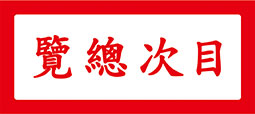In the 1st year of the Tao-kuang reign (1821), Soong Yüeh-ch’iao (宋月樵) from Wu-ch’eng (烏程), Chao Ch’iu-ling (趙秋舲) from Jen-ho (仁和), met at the provincial examination in Hangchou (杭州). They later became close friends. In the 9th year of the Tao-kuang reign (1829), Soong Yüeh-ch’iao was appointed to office in Fukien (福建), and Chao Ch’iu-ling composed a tz’u lyric To the tune of Mo yü erh (摸魚兒) as a parting gift. This was compiled into his anthology Hsiang-hsiao chiu-hsing tz’u (香消酒醒詞).
In the 67th year of the Republic (1978), the great- great-grandson Soong Hsün-leng (宋訓倫) was residing in Hong Kong, and he came across the tz’u lyric To the tune Mo yü-erh in Hsiang-hsiao chiu-hsing tz’u. He was enthralled and asked the well known painter Ch’eng Chieh-tzu (程芥子) in Taiwan to paint Farewell by Autumn River, a depiction of the tz’u lyric. This painting was meant to remember his ancestor, and to alleviate his yearning for the lost homeland.
Now the son of Soong Hsün-leng (宋訓倫), Soong Shu-kong (宋緒康), narrates the generations of intense sentiments that intertwine with the tz’u lyric To the tune Mo yü-erh, from the 1st year of the Tao-kuang reign to the present, in a span of over two hundred years. Although the world has been transformed altogether, the residual allure of the refinement from the world of classical arts, still prevails.
Curatorial and Editorial Department
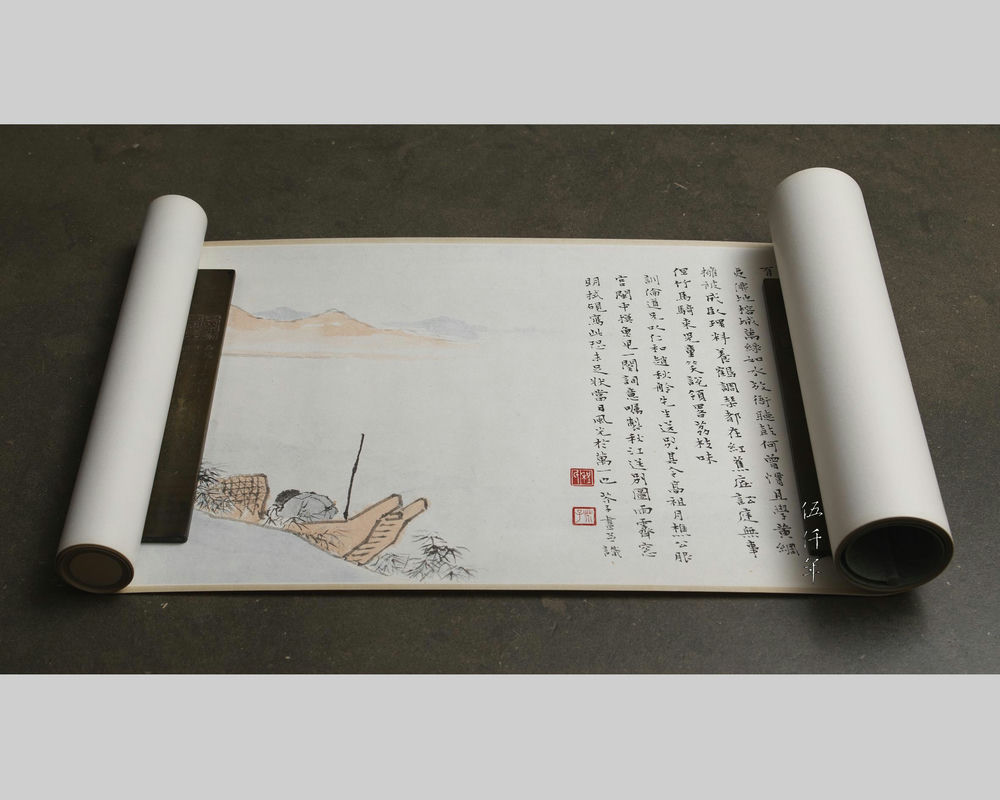
Farewell by Autumn River, painted by Mr. Ch’eng Chieh-tzu
In August, the first year of the Tao-kuang reign, autumn of hsin-ssu year (辛巳 1821), the city government of Hangchou, capital of Chekiang province, held a provincial examination to select provincial graduates, known as chü-jen (擧人). Provincial examinations were customarily held every three years in August during autumn, hence they were known as ch’iu-wei, autumn examinations (秋闈). However the provincial examination held in hsin-ssu was only two years apart from the provincial examination held in the 24th year of the Chia-ch’ing reign (1819). For Jen-tsung emperor (仁宗 1760-1820) died in the 25th year of the Chia-ch’ing reign (1820), Hsüan-tsung (宣宗 1782-1850) succeeded the throne, the name of the reign was changed to Tao-kuang, and a special irregular provincial tribute examination was held, known as en-k’ei (恩科).

The City of Wu-hsing, also known as Hu-chou
My ancestors migrated from the north to Wu-ch’eng county, Wu-hsing city, Chekiang province, during the end of the Ming dynasty. My fourth great-grandfather the Hon. Soong Yüeh-ch’iao (宋月樵) went to the city of Hangchou in hsin-ssu year to participate in the provincial examination. In the examination hall he met Mr. Chao Ch’iu-ling (趙秋舲) from Jen-ho county, Hangchou city. When the results were announced, both attained the chü-jen degree, and became t’ung-nien (同年). In the past, those who participated and successfully passed the same provincial or metropolitan examination, or successfully passed the provincial or metropolitan examination in the same year, addressed each other as t’ung-nien. It was a social custom in the era of competitive examinations, known as k’o-ch’ü (科擧). The counties of Wu-ch’eng and Jen-ho are neighbors, separated by a few scores of miles. In the following years, the Hon. Soong Yüeh-ch’iao and Mr. Chao Ch’iu-ling communicated regularly, and became close friends.

Hall of Preserving Harmony in the Forbidden City
In February, in the spring of the 2nd year of the Tao-kuang reign (1822), Mr. Chao Ch’iu-ling arrived in Peking, the capital, to participate in the metropolitan examination, known as hui-shih (會試). After passing the examination for kung-shih (貢士), he could then attend the confirmatory April palace examination for the ranking of metropolitan graduates, known as chin-shih (進士). Since the reign of Ch’ien-lung, palace examinations were held on 21st April, in the Hall of Preserving Harmony in the Outer Court of the Forbidden City. The examination questions were prepared by the emperor, thus the term palace examination, or court examination. The metropolitan examinations were also customarily held every three years during spring, known as ch’un-wei, spring examinations (春闈). With the ascension of Hsüan-tsung as emperor, a special irregular tribute metropolitan examination was also introduced. Mr. Chao Ch’iu-ling attained his chin-shih degree at the jen-wu year (壬午) tribute palace examination, in the 2nd year of the Tao-kuang reign (1822), ranked Second Class Number Forty Six. The Hon. Soong Yüeh-ch’iao participated in the palace examination seven years later, he attained the chin-shih degree at the chi-ch’ou year (己丑) palace examination, in the 9th year of the Tao-kuang reign (1829), ranked Second Class Number One Hundred and Three.
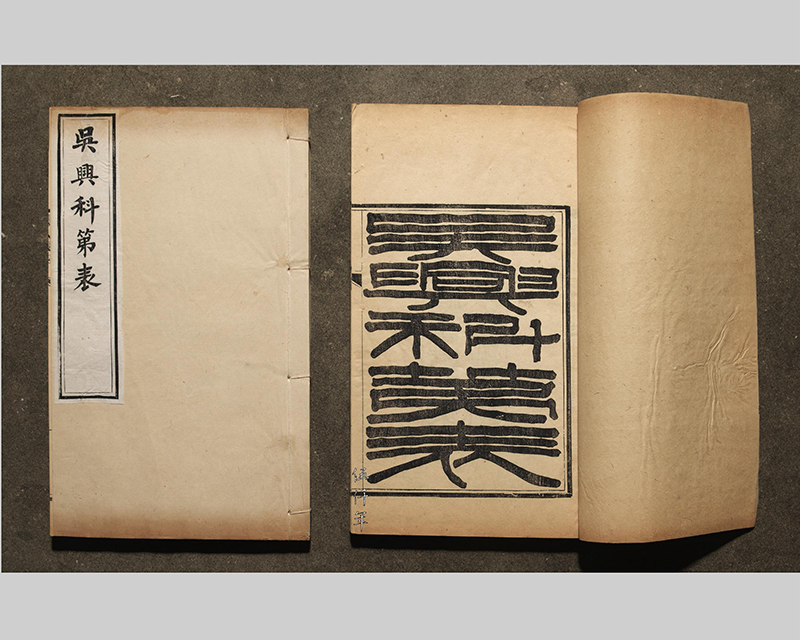
Front cover and title page of Public Examination Records of Wu-hsing City
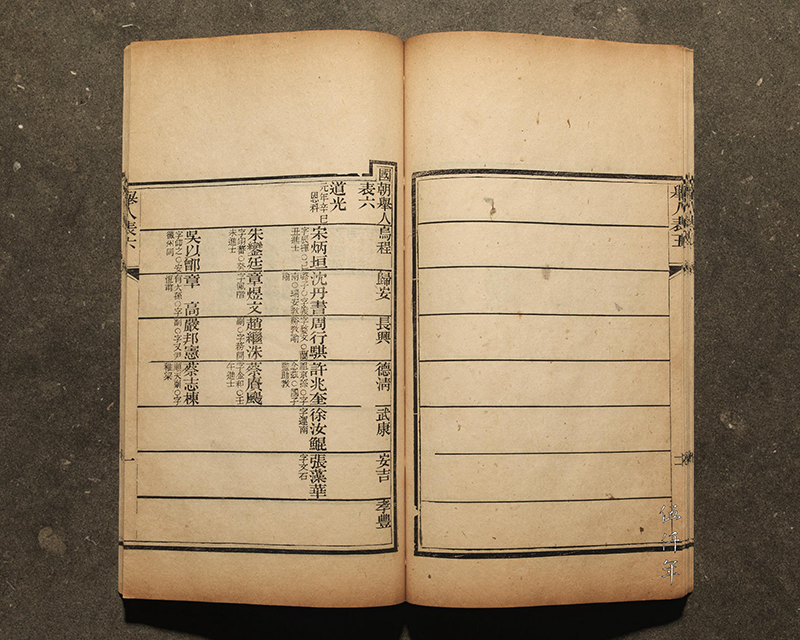
The Hon. Soong Yüeh-ch’iao attained the chü-jen degree in 1821, chronicled in the Public Examination Records of Wu-hsing City
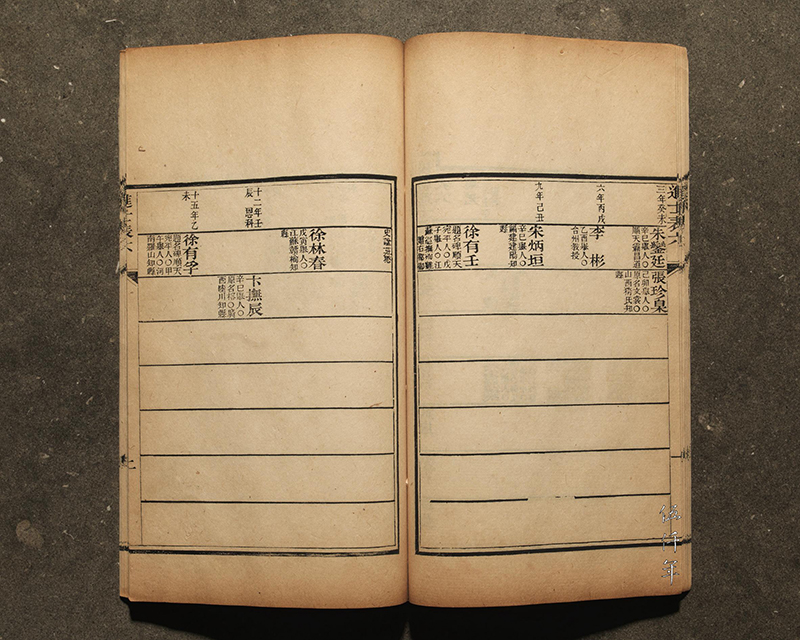
The Hon. Soong Yüeh-ch’iao attained the chin-shih degree in 1829, chronicled in the Public Examination Records of Wu-hsing City
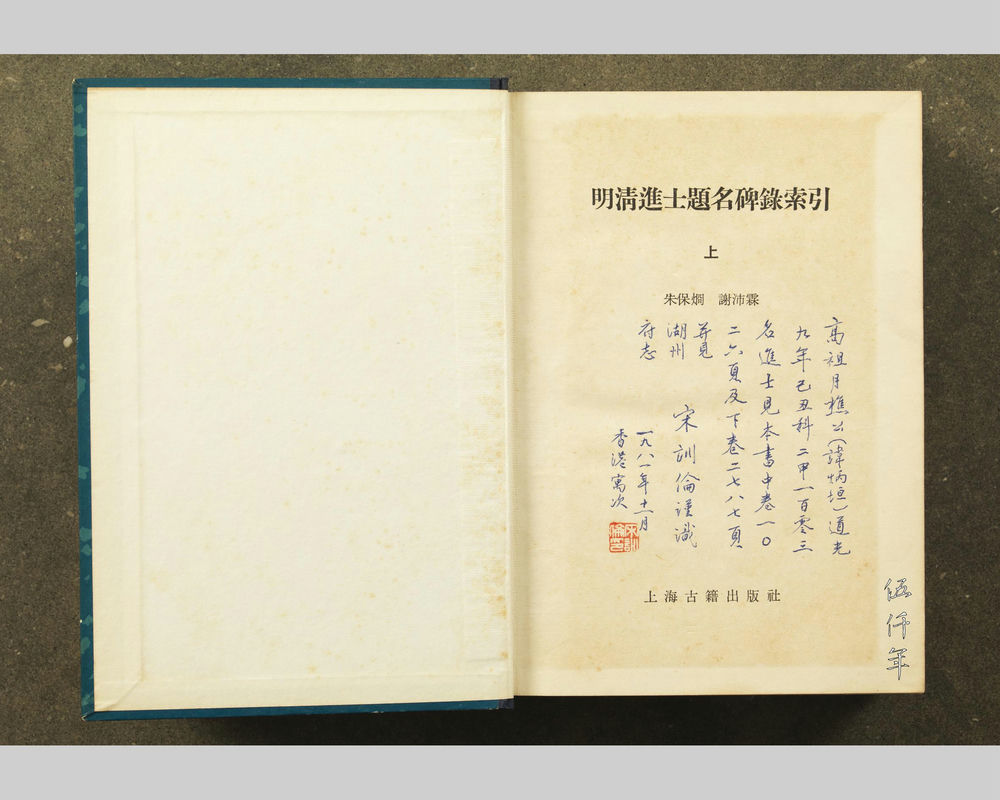
Mr. Soong Hsün-leng wrote a colophon on the title page of Volume One of An Index of Chin-shih Records on Stone Stelae from Ming and Ch’ing Dynasties
My departed father Mr. Soong Hsün-leng wrote two colophons on the title pages of Volume One and Volume Three of An Index of Chin-shih Records on Stone Stelae from Ming and Ch’ing Dynasties (明清進士題名碑錄索引). The colophon in Volume One reads:
“My third great-grandfather the Hon. Soong Yüeh-ch’iao, original name Ping-yüan (炳垣), attained the chin-shih degree at the chi-ch’ou year examination, in the 9th year of the Tao-kuang reign, ranked Second Class Number One Hundred and Three. This is documented in Volume Two of this book, page 1026, and Volume Three, page 2787. Also chronicled in The Gazetteer of Hu-chou.
Attentively recounted by Soong Hsün-leng, November 1981, during a sojourn in Hong Kong.”
Seal impression: Seal of Soong Hsün-leng
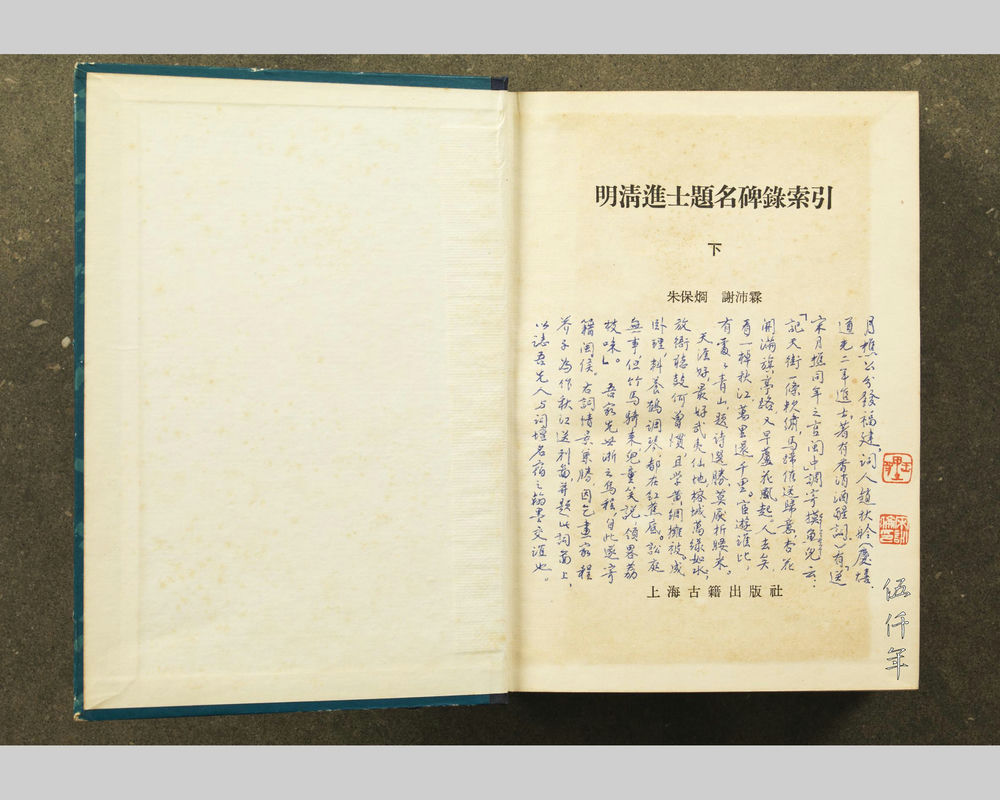
Mr. Soong Hsün-leng wrote a colophon on the title page of Volume Three of An Index of Chin-shih Records on Stone Stelae from Ming and Ch’ing Dynasties
The colophon in Volume Three reads:
“The Hon. Soong Yüeh-ch’iao was appointed to office in Fukien. The tz’u poet Chao Ch’iu-ling (original name Ch’ing-hsi, 慶熺, chin-shih of the 2nd year of the Tao-kuang reign, his collection of tz’u poems titled Hsiang-hsiao chiu-hsing tz’u 香銷酒醒詞) wrote:
To the tune Mo yü erh (摸魚兒)
Farewell to t’ung-nien Soong Yüeh-ch’iao leaving for office in Fukien.
To recall
Supple vista
Of opulence
On Celestial Avenue.
Hooves clopping,
Hasten onward,
Musings for home.
Plum blossoms
Bloom and brim
Along the tavern road.
Another morning
Of reed flowers
And fall gusts.
Alas you have left,
Carrying my eyes,
By a boat
In Autumn river.
Ten thousand miles,
Can it be so,
A thousand miles?
Who can match
An official vocation
Such as yours?
Green hills,
Here and there,
Only everywhere.
Writing poetry,
Indulge in sceneries.
Do not be weary
Stooping for stipend!
Across the world,
It is nonetheless fine.
But still no finer
Than the fairyland
Of Wu-i Mountain. 1
Infinite green
In the City of Jung 2
Flowing like river.
Drum in morning,
Adjourn in evening,
Routine of an official,
Ever arduous to adjust.
So adapt with a nap
In yellow silk blanket!
Conduct the office
In a state of repose!
Look forward my friend!
Raise the cranes,
Wind the zither strings,
All under red banana trees.
Idle and disused
The Hall of Litigation.
Only children galloping by
On toy bamboo horses,
Giggling and saying:
Find out the taste of lychees!
1. Wu-i Mountain is a mountain in Fukien province.
2. The City of Yung is another name for the capital of Fukien province, Fu-chou City.
My ancestors came from Wu-ch’eng of Chekiang province, from then we partially resided in Fukien. The tz’u on the right excels in both sentiments and vistas, so I beseeched the painter Ch’eng Chieh-tzu (程芥子) to paint Farewell by Autumn River, and inscribed this tz’u on the painting, to chronicle the literary friendship of my ancestor with an eminent figure in tz’u poetry.”
Seal impressions: Yü-li, Seal of Soong Hsün-leng.
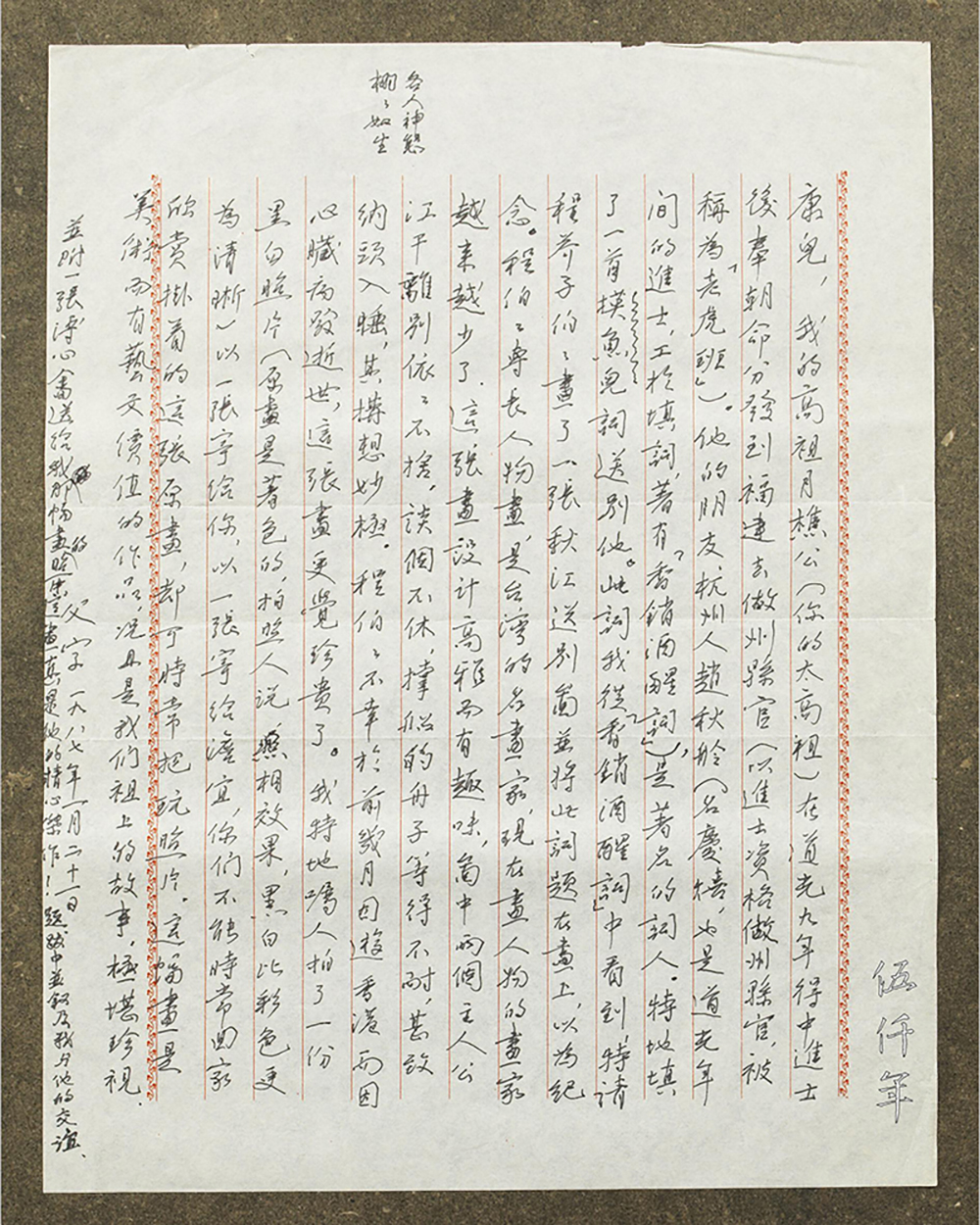
First letter by Mr. Soong Hsün-leng accompanied with the photograph of Farewell by Autumn River
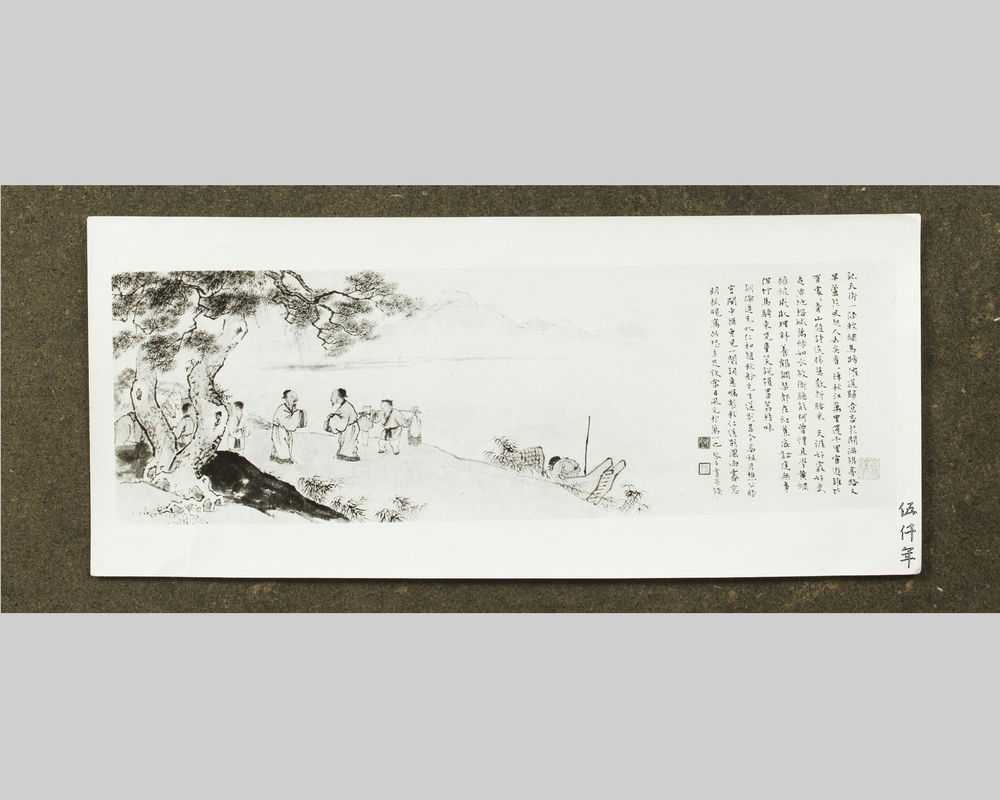
In the 76th year of the Republic (1987), I was twenty five and studying in England. My father wrote me a letter, it reads:
“To son Kong:
My third great-grandfather the Hon. Soong Yüeh-ch’iao (your forth great-grandfather), attained his chin-shih degree in the 9th year of Tao-kuang reign. The court appointed him to Fukien to the position of district official in charge of prefecture 州 (those district officials in charge of prefecture with chin-shih qualifications, were called Lao-hu pan 老虎班). His friend from Hangchou Chao Ch’iu-ling (original name Ch’ing-hsi, was also chin-shih of Tao-kuang period, he excelled in poetry and tz’u, and wrote Hsiang-hsiao chiu-hsing tz’u) was an eminent tz’u poet. He specially composed a tz’u To the tune Mo yü erh to bid him farewell. I read this tz’u in Hsiang-hsiao chiu-hsing tz’u, and particularly asked Uncle Ch’eng Chieh-tzu to paint Farewell by Autumn River for remembrance. Uncle Ch’eng specialized in figure painting, and he was a famous painter in Taiwan. There are less and less figure painters nowadays. The composition of this painting is elegant and delightful. The two main characters in the picture cannot bear to part, they keep talking endlessly, the boatman in charge of oaring is waiting impatiently, he even rested his head to sleep. The expressions on everyone are just as alive. The concept is exceptionally subtle. Unfortunately, a few months ago, when visiting Hong Kong, Uncle Ch’eng had a heart attack and passed away. This painting is even more precious. I specially requested someone to take a black and white photograph (the original painting is colored, the photographer claimed for effect, black and white photograph is clearer than colored photograph), a copy is to be sent to you, a copy is to be sent to Tan-i (澹宜). You are unable to come home frequently to appreciate the original painting hanging on the wall, but you can regularly amuse yourself with the photograph. This painting is a work of art with literary value, besides, it is a story about our ancestor. It deserves to be truly treasured.
Words by Father.
21st January 1987
I am also enclosing a photograph of the painting gifted to me by P’u Hsin-yü. This is indeed his masterpiece! The colophon recounted our friendship.”
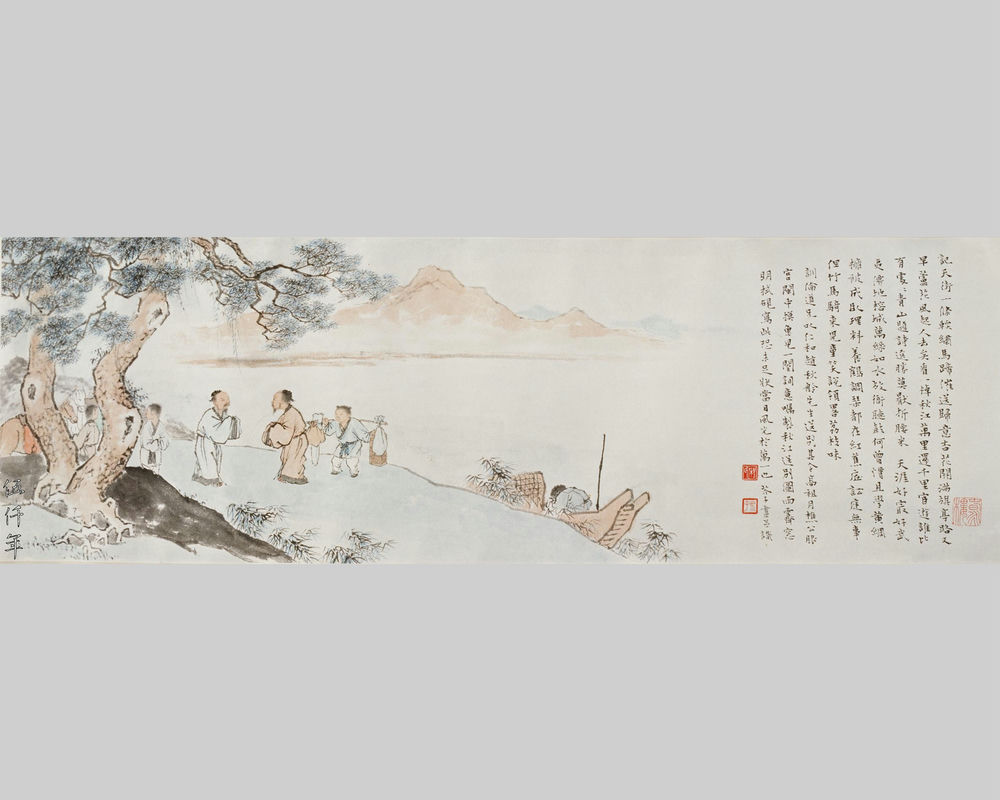
Full length view of Farewell by Autumn River, painted by Ch’eng Chieh-tzu
Uncle Ch’eng Chieh-tzu inscribed To the tune Mo yü erh on Farewell by Autumn River, with an additional colophon which reads:
“My friend Hsün-leng asked me to paint the picture Farewell by Autumn River, using the meaning of To the tune Mo Yü erh, a tz’u poem dedicated to his third great-grandfather the Hon. Soong Yüeh-ch’iao, by Mr. Chao Ch’iu-ling from Jen-ho. The rain had stopped and the window was bright, I wiped clean the inkstone to write this. I am afraid the painting is unable to depict a fraction of the scene on that day. Painted and inscribed by Chieh-tzu.”
Seal impressions: The House of Ch’eng, Chieh-tzu, Spring Water Tower
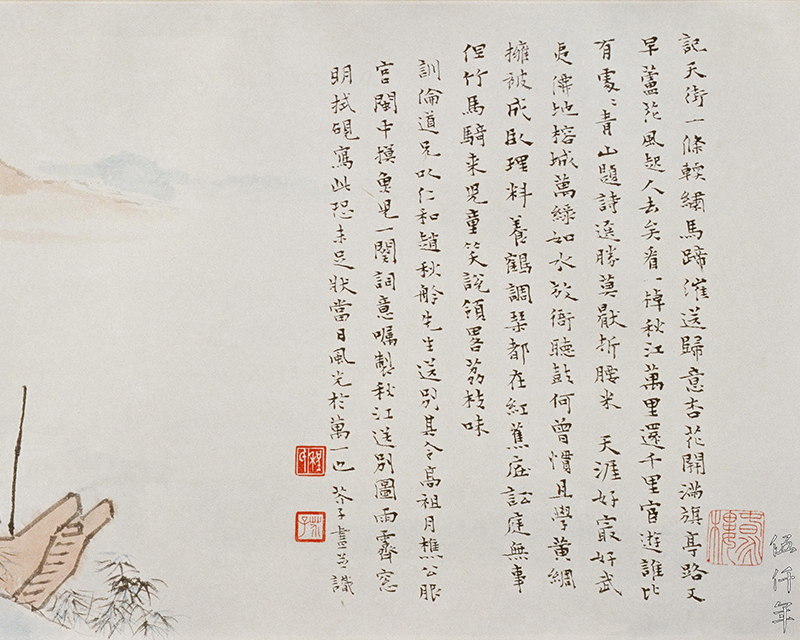
First detail of Farewell by Autumn River
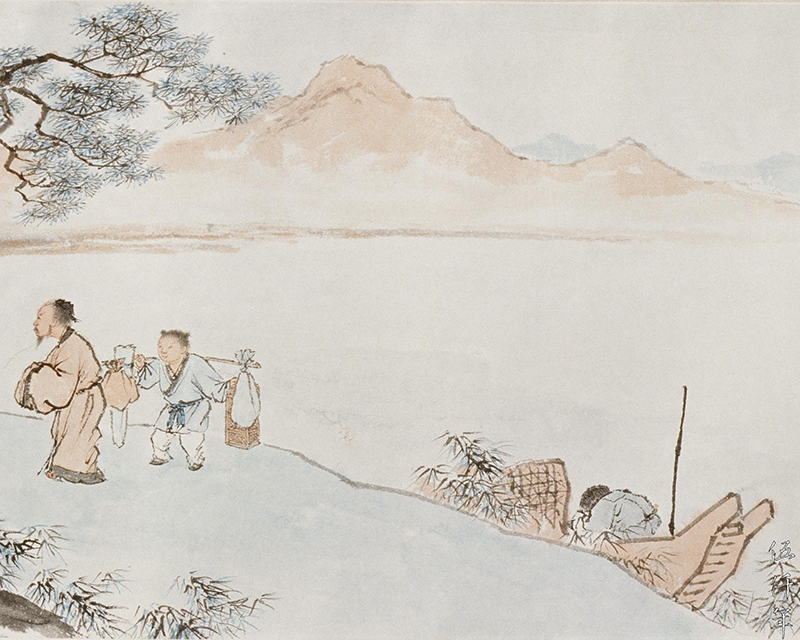
Second detail of Farewell by Autumn River
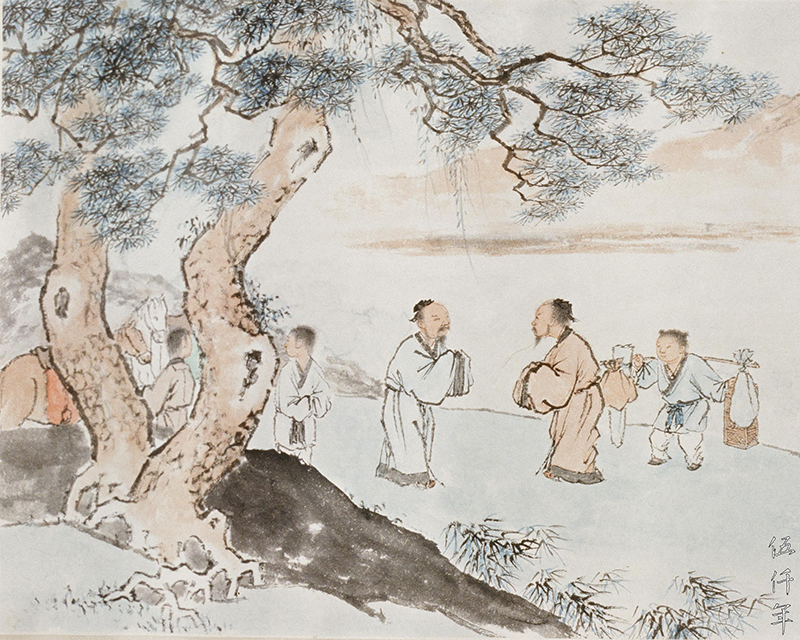
Third detail of Farewell by Autumn River
The colophon did not mention the year nor the month of its execution. When my father wrote the colophon in An Index of Chin-shih Records on Stone Stelae from Ming and Ch’ing Dynasties in the 70th year of the Republic (1981), he already mentioned the painting by Uncle Ch’eng Chieh-tzu. Hence the painting should be executed in 1981 or earlier. I have seen a simpler version of Farewell by Autumn River by Uncle Ch’eng Chieh-tzu in the market, it was inscribed with wu-wu year (戊午 1978), thus one can conclude that Farewell by Autumnn River was painted in the 67th year of the Republic, 1978. The original name of Uncle Ch’eng was Liu-shen (柳燊), he preferred to use his tzu Chieh-tzu. He was a native of Yü-yao, Chekiang province. He was born in the 2nd year of Hsüan-t’ung reign (1910), according to my father’s letter, the year of his death should be the 75th year of the Republic (1986), and not the commonly acknowledged year of 1987.
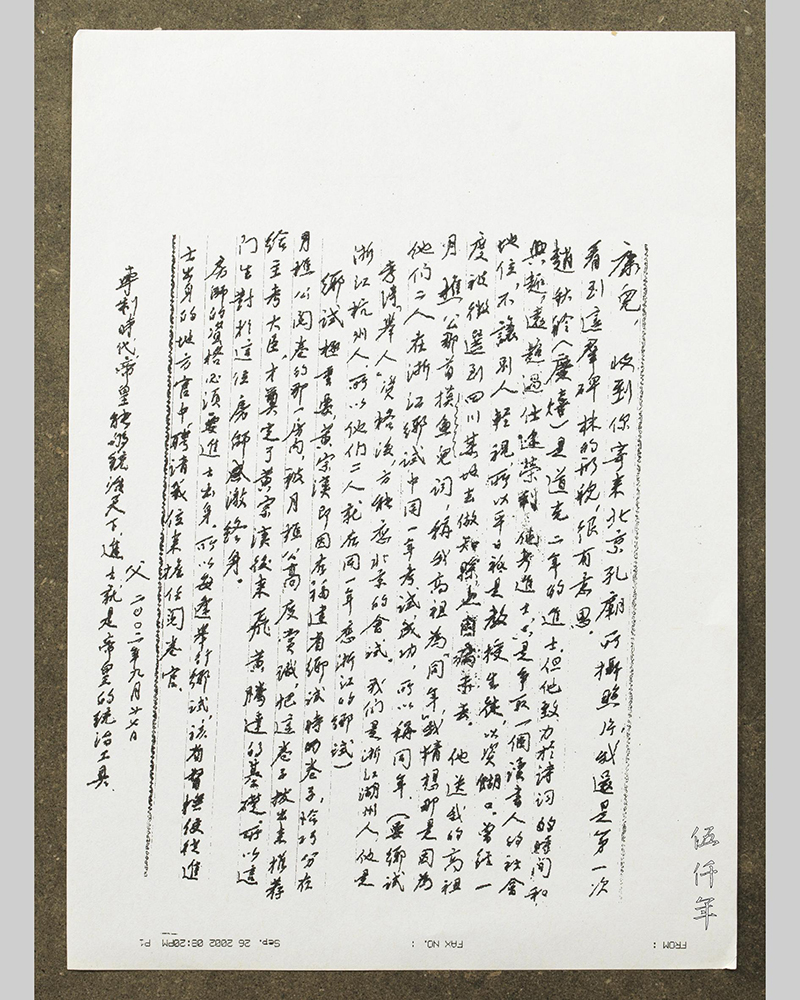
Second letter by Mr. Soong Hsün-leng
Another fifteen years passed. In the 91st year of the Republic, 2002, I was forty, and permanently living in Taiwan. My father wrote me a letter. It reads:
“To son Kong:
I received the photographs of the Confucius Temple in Peking you sent me. It was actually my first time seeing this group of stone stelae. It is very meaningful.
Chao Ch’iu-ling was a chin-shih of the 2nd year of the Tao-kuang reign. The time and interest he endeavored in poetry and tz’u, far exceeded those he spent in officialdom for glory and profit. He participated in the examination for chin-shih, in order to attain the social standing of a scholar, as not to be looked down upon. That is why in his days he only taught students, a means to make a living. He was once selected to be a district official somewhere in Szechuan province, because of illness he did not go. In To the tune Mo yü erh he presented to my third great-grandfather the Hon. Soong Yüeh-ch’iao, he addressed him as t’ung-nien. I guess they were both successful in the same provincial examination of Chekiang province. Hence he called him t’ung-nien. (It was necessary to attain the qualification of chü-jen first, then it was possible to attend the metropolitan examination in Peking. We are native of Hu-chou of Chekiang province, he was native of Hangchou of Chekiang province, so both of them participated in the provincial examination of Chekiang province in the same year).
Provincial examination was very important. Huang Tsung-han (黃宗漢 1803-1864) participated in the provincial examination of Fukien province, his papers happened to be allocated to the room where the Hon. Soong Yüeh-ch’iao was assigned, and they were highly appreciated by him. He took them out and recommended them to the Grand Minister Examiner. This laid the foundation of the rapid advancements in official career for Huang Tsung-han later on. Hence this disciple was indebted life long to his Minister Examiner.
Minister Examiner must be a qualified chin-shih, whenever a provincial examination was to be held, the provincial governor would invite a few provincial officials with chin-shih qualifications to take up the posts of Minister Examiners.
Father.
27th September 2002.
In autocratic era, for the emperor to rule the whole country, the class of chin-shih was the emperor’s instrument of governance.”

Mr. Soong Hsün-leng wrote a colophon in the inside page of Volume Three of An Index of Chin-shih Records on Stone Stelae from Ming and Ch’ing Dynasties
My father mentioned the stone stelae in the Confucian Temple of Peking. This is the Confucian Temple on Kuo-tzu-chien Street that displays stone stelae, carved with names of those who attained the chin-shih degree from the Yuan, Ming and Ch’ing dynasties. In former times, scholars paid great attention to public examination, however, they did not necessarily behold blind faith. My father wrote an inscription on the page that documented the names of chin-shih in the 9th year of the Tao-kuang reign, in An Index of Chin-shih Records on Stone Stelae from Ming and Ch’ing Dynasties. It reads:
“My third great-grandfather the Hon. Soong Yüeh-ch’iao was ranked Second Class Number One Hundred and Three. Attentively recounted by Hsün-leng.
As eminent a scholar as Kung Tzu-chen (龔自珍), his name was ranked Third Class. Public examination certainly does not deserve worthwhile conversation.”
Kung Tse-chen (1792-1841), tzu Se-jen (璱人), Erh-yü (爾玉), Ting-an (定庵), original name Kung-zuo (鞏祚), native of Jen-ho, Chekiang province. He attained the chin-shih degree at the chi-ch’ou year palace examination, in the 9th year of the Tao-kuang reign, and was ranked Third Class Number Nineteen. Hence he was a t’ung-nien of the Hon. Soong Yüeh-ch’iao. Kung was deeply interested in the Confucian Classics, Confucian Classics in official script of the Han dynasty, history, Mongolian language, geography of north west China, philosophers in 6th century BC to 221 BC, Taoism, Buddhism, epigraphy as well as mathematics. His poetry and writing are encompassing, stylish and individualistic, certainly an erudite scholar of his generation. However his path in public examinations was full of setbacks. Since attaining the chü-jen degree in the 23rd year of Chia-ch’ing reign (1818), in the next eleven years, he participated in six rounds of metropolitan examinations, including two special irregular tribute examinations, and failed in five. Only until the 9th year of the Tao-kuang reign did he pass to become a chin-shih. In view of this, public examination was altogether inadequate to gauge one’s learning.
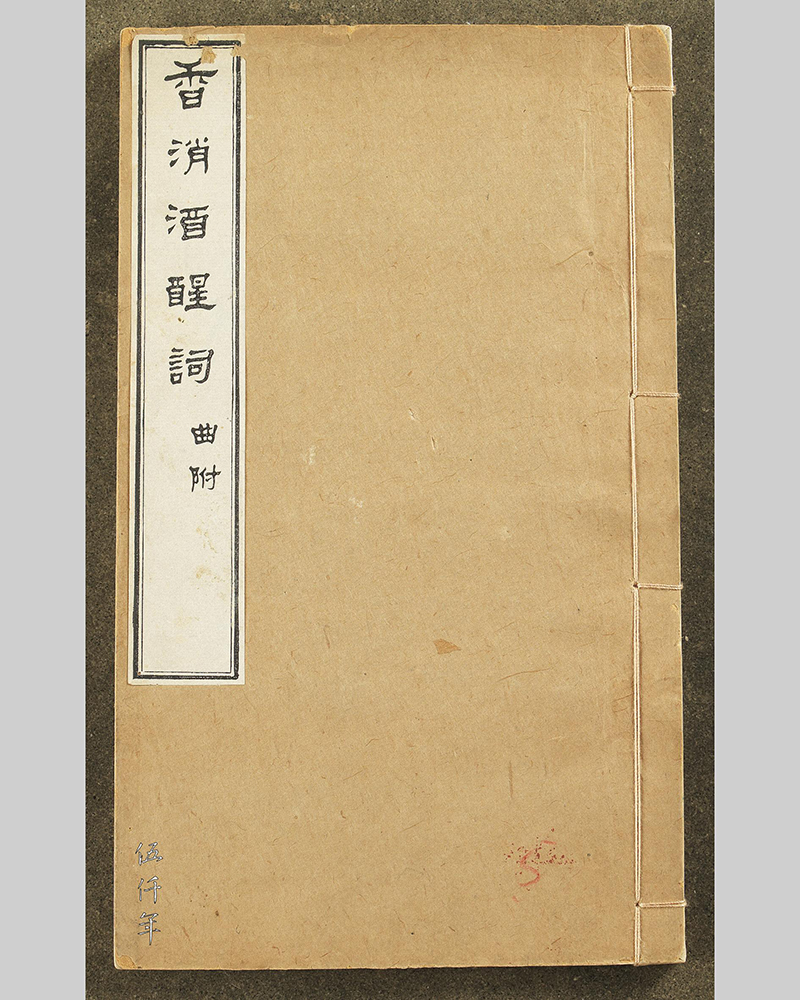
Front cover of Hsiang-hsiao chiu-hsing tz’u by Mr. Chao Ch’iu-ling

Title page of Hsiang-hsiao chiu-hsing tz’u by Mr. Chao Ch’iu-ling
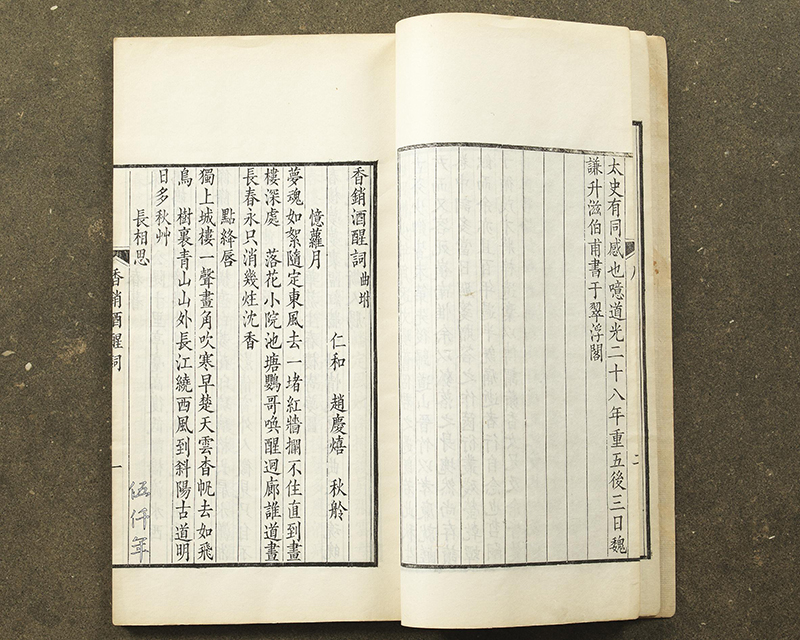
Inside page of Hsiang-hsiao chiu-hsing tz’u by Mr. Chao Ch’iu-ling

To the tune Mo yü erh in Hsiang-hsiao chiu-hsing tz’u
The works by Chao Ch’iu-ling is Hsiang-hsiao chiu-hsing tz’u (香銷酒醒詞), also known as 香消酒醒詞. The second character 銷 and 消 are occasionally interchangeable. There is a prologue written by Wei Tzu-po (魏滋伯 1797-1861), original name Ch’ien-sheng (謙升), on the third day after the Dragon Boat Festival in the 28th year of the Tao-kuang reign (1848), which is equivalent to the date 8th May (Chinese Lunar Calender). The calligraphy in official script on the title page was written by the distinguished seal engraver, calligrapher and painter Chao Tz’u-hsien (趙次閑), original name Chih-ch’en (之琛), on first January of the 29th year of the Tao-kuang reign (1849). There is a postscript by Hsü Chi-chai (許吉齋), original name Nai-an (乃安), written after January of the 29th year of the Tao-kuang reign (1849). We can conclude that Hsiang-hsiao chiu-hsing tz’u was published in the spring of the 29th year of the Tao-kuang reign (1849).
In the postscript by Hsü Chi-chai, he wrote:
“In ping-wu year (丙午 1846), I was an official in Lan-Chou. I heard he (Chao Ch’iu-ling) was gravely ill. I rushed a letter and said that I would soon fix a date to return. Why not wait awhile for me to resign in ting-wei year (丁未 1847)? Half way on my journey, news of his death arrived. After my return, I sought his manuscript. My cousin showed me a copy and said: This is a collection of tz’u poems written by my father, it has been edited by the hands of Lady Wu P’ing-hsiang (吳蘋香 1799-1863), and Wei Tzu-po (Kuang-wen) wrote a prologue.”
Mr. Chao Ch’iu-ling became gravely ill in ping-wu year, 1846. In the following year, ting-wei year, 1847, the 27th year of the Tao-kuang reign, he passed away. Lady Wu P’ing-hsiang was a close literary companion of Mr. Chao, she was a well known tz’u poetess, and was entrusted to edit his works. Her original name was Tsao (藻), native of Jen-ho, Chekiang province. Her works are Hua-lien tz’u (花簾詞) and Hsiang-nan hsüeh-pei tz’u (香南雪北詞).
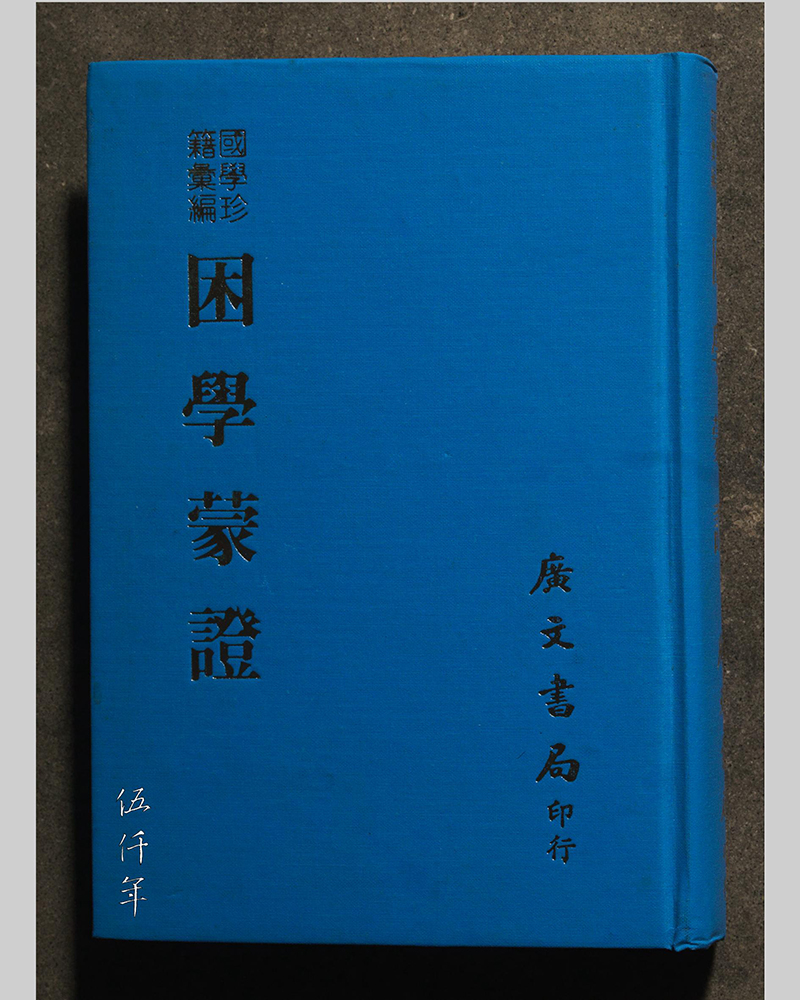
Front cover of K’un-hsüeh meng-cheng by the Hon. Soong Yüeh-ch’iao
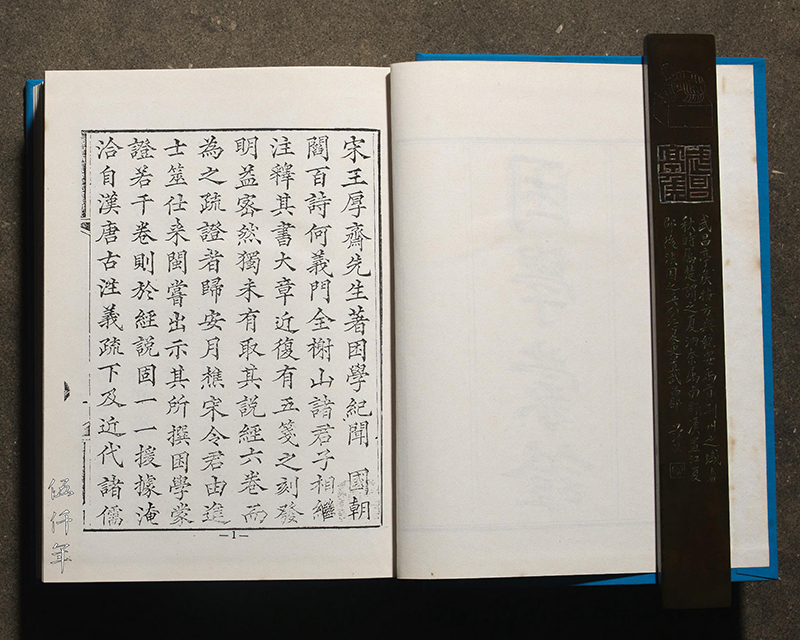
Prologue by Ch’en Kung-fu in K’un-hsüeh meng-cheng, written by the Hon. Soong Yüeh-ch’iao

Prologue by Wu Po-hsin in K’un-hsüeh meng-cheng, written by the Hon. Soong Yüeh-ch’iao
The Hon. Soong Yüeh-ch’iao, his original name Ping-yüan, tzu Ch’en-hui (辰輝), Wei-ch’ing (薇卿), Yüeh-ch’iao. In the Public Examination Records of Wu-hsing City (吳興科第表), it was documented that he was appointed district official of Chien-yang county of Fukien province. In the Biographies of Eminent Men from Wu-chou (湖州名人志), it was so recorded:
“Soong Ping-yuan, native of Wu-ch’eng. He was a calligrapher of the Ch’ing dynasty. He studied the calligraphy of Su Shih (蘇軾), and particularly distinguished himself in the calligraphic style of hollow strokes (飛白). He attained the chin-shih degree in the 9th year of the Tao-kuan reign, and in the 13th year of Tao-kuan reign (1833), he was appointed district official of Ming-hsi county of Fukien province, he was also appointed district official of Ku-t’ien county.”
From this we learned that the Hon. Soong Yüeh-ch’iao was consecutively appointed district official of three counties: Chien-yang, Ming-hsi and Ku-t’ien of Fukien province. His works are K’un-hsüeh meng-cheng in six volumes (困學蒙證六卷). There is a prologue by Ch’en Kung-fu (陳恭甫), original name Shou-ch’i (夀祺), dated 3rd May, summer of keng-yin year, the 10th year of the Tao-kuang reign (1830). Some lines read:
“The county magistrate Soong Yüeh-ch’iao from Kuei-an, was assigned to the office in Fukien through his chin-shih qualification. He once showed me a few volume of his writings titled K’un-hsüeh meng-cheng. As for his writings on the Confucian Classics, they are certainly backed by broad citations and vast learning.”
From this we knew that the Hon. Soong Yüeh-ch’iao had already arrived in Fukien by the summer of 1830. Hence To the tune Mo yü erh by Mr. Chao Ch’iu-ling would be composed in the Autumn of the 9th year of the Tao-kuang reign (1829), over one hundred and ninety years ago.
There is another prologue by Wu Po-hsin (吳伯新), original name Hsiao-ming (孝銘). Some lines are:
“In i-wei year (1835), I came to inspect this land, (Soong Yüeh-ch’iao) visited me at the Commissioner Office, he showed me his works K’un-hsüeh meng-cheng, and beseeched me to write something to be placed in the front.”
I-wei is the 15th year of the Tao-kuang reign (1835), this book should be printed in that year. I once read the article An Investigation on the Authorship of K’un-hsüeh meng-cheng (困學蒙證著者考) by Mr. Lo Lin (羅琳). It is an important study on my ancestor.
Forty something years ago, my father was living in Hong Kong. By chance he came across To the tune Mo yü erh by Mr. Chao Ch’iu-ling. At the time mainland China had already fallen for nearly thirty years, for him to encounter a time-worn trace from our old family, it was a blend of joy and sorrow. In the 67th year of the Republic (1978), he asked his far away friend Ch’eng Chieh-tzu from Taiwan, to paint Farewell by Autumn River, to encapsulate the flavour of a bygone story about his third great-grandfather. My father was anxious that the young generation might not treasure it, and the painting could be left in a state of desolation. So he wrote a letter to me in London, in the 76th year of the Republic (1987), to explain the context of the painting, and to ease his worry that traditional Chinese culture would one day dissolve in our family! Another fifteen years passed by, in the 91st year of the Republic (2002), he faxed another letter to Taiwan, to reiterate the story of the painting. The transplant of a classical literary tradition, how formidable is the task! Almost twenty years ago, I remounted Farewell by Autumn River into a handscroll, to be better suited for long term preservation. Six years afterwards, I asked my departed friend Mr. Shen Ying-tung (沈映冬) to write the title slip on the handscroll. It reads:
“Ch’eng Chieh-tzu painted Farewell by Autumn River. Shen Ying-tung respectfully inscribed these words. A seal was impressed: Ying-tung is happy.”
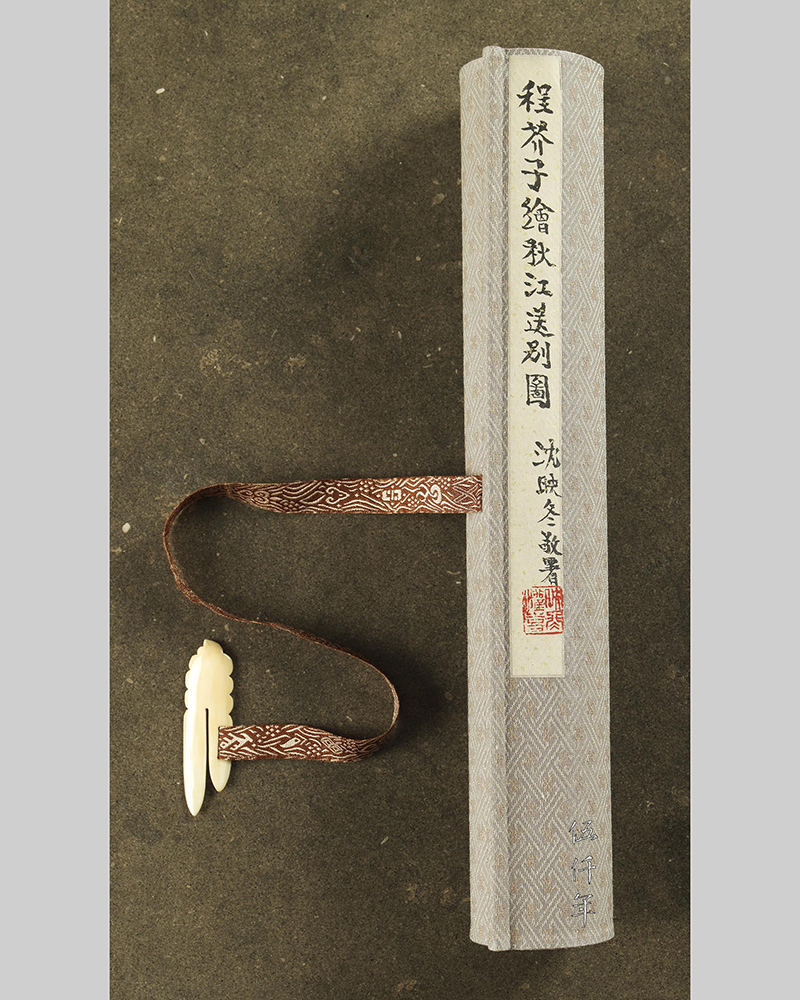
Title slip on the handscroll written by Mr. Shen Ying-tung
A friendship formed during Autumn examination, a tz’u poem composed in the Tao-kuang era, in the span of a hundred and ninety years, not only has this sentiment of friendship not receded, it has been enriched, layered into ripples of diverse sentiments, the sentiment towards ancestors, the sentiment towards country, the sentiment between father and son, and the sentiment of friendships through a few generations. They have been transformed into artistic and literary expressions, and appear in the mediums of colophons in books, painting, letters and title slip of handscroll. This is adequate demonstration that despite the innumerable catastrophes of this mortal world, only our fathomless sentiments are hard to extinguish.

The two main characters in the picture cannot bear to part
